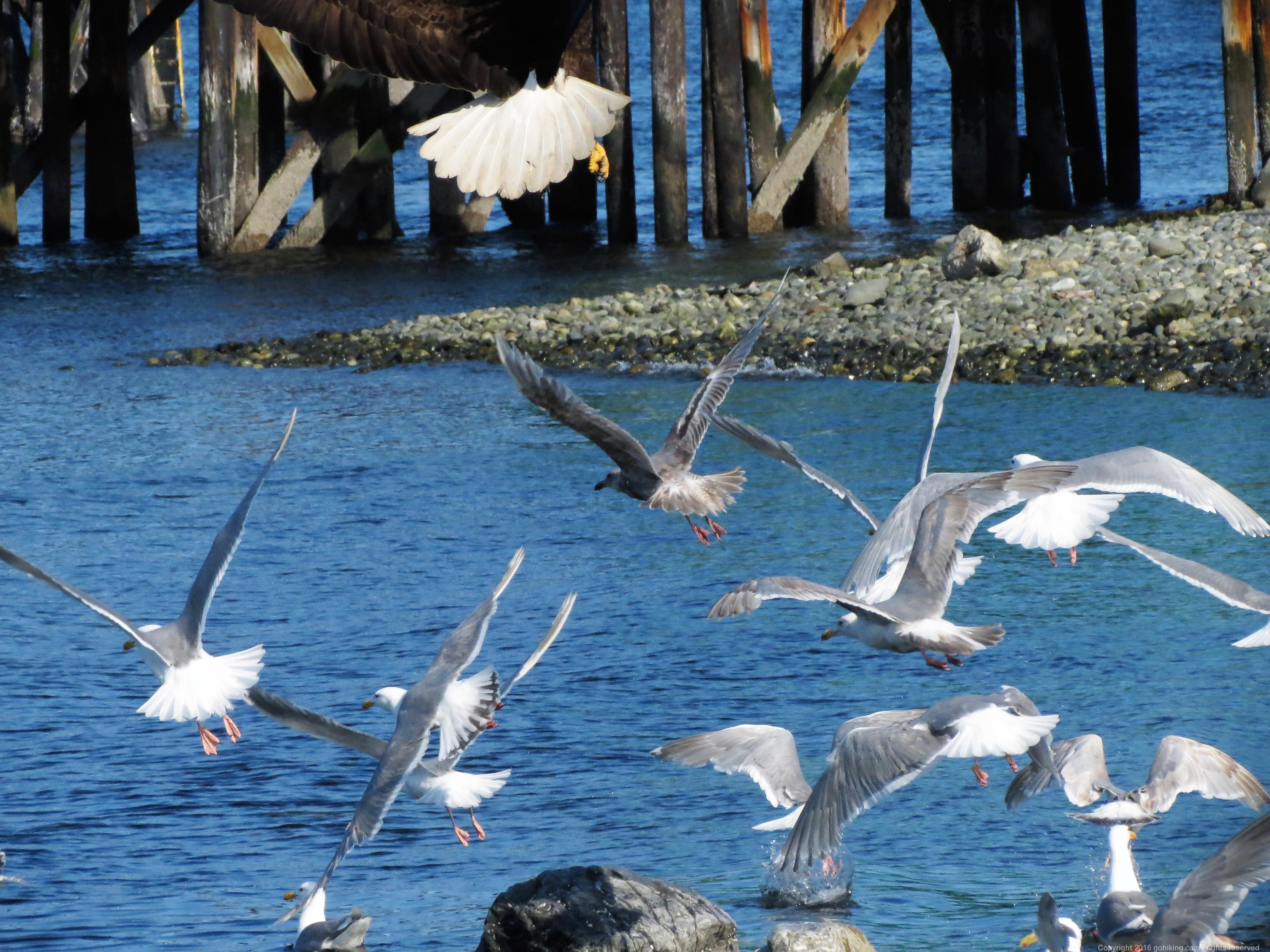The adult Herring Gull is about 60 cm long from the tip of its bill to the tip of its tail. It has a white head, body, and tail, its bill is yellow with a red spot on the lower tip, and its legs are pink. The backs and upper wing surface of adult birds are grey and the tips of their outermost flight feathers are black with a white spot. In winter, the heads of adult gulls are streaked with brown. Immature birds are mottled brown and take four years to develop their adult plumage.
The Herring Gulls like to gather on beaches along the coastal shores during the winter. In other seasons, gulls may range inland and can be found beside lakes and rivers, garbage dumps, farmer’s fields, islands, cliffs, and buildings.
 Herring gulls can be quite useful in keeping our beaches clean by eating any and all edible debris. The Herring gull nests in a variety of sites, but is always near a body of water. On offshore islands, they frequently occupy flat ground. On the mainland, however, they tend to nest on cliffs, probably to avoid predatory mammals. In some places where food from human activities is abundant, they have begun to nest on roofs and window ledges of buildings. On cliffs, herring gulls tend to nest on grass-covered ledges.
Herring gulls can be quite useful in keeping our beaches clean by eating any and all edible debris. The Herring gull nests in a variety of sites, but is always near a body of water. On offshore islands, they frequently occupy flat ground. On the mainland, however, they tend to nest on cliffs, probably to avoid predatory mammals. In some places where food from human activities is abundant, they have begun to nest on roofs and window ledges of buildings. On cliffs, herring gulls tend to nest on grass-covered ledges.
The Herring gull is a very social bird and prefers to nest in colonies. Once a colony is well established, they are faithful to it and reluctant to settle elsewhere. On Mitlenatch Island in Johnston Straight for example, older, experienced breeding birds usually stay close to their colonies and are the first to reoccupy nesting territories in early spring. Some may use the same nesting site for as long as 20 years.
As the colony grows, some birds are unable to establish breeding territories. Sooner or later, these birds start to hang out near abundant food supplies. As the urge to breed grows, some start nesting at the new site, and the rush is on to nest there.
The Herring gull is one of the most widespread species in Canada. Indeed, their breeding range includes every province and territory in Canada. Of the 43 species of gull found in the world, 16 breeds in Canada.

Herring gulls regurgitate food remains that they cannot digest. Analyses of these “pellets” and of their feces show that herring gulls, like most other gull species, will eat almost anything—clams, small fish, floating dead animals, small young and adults of other nesting birds, bread, french fries, and unfortunately, plastics.
Individual herring gulls tend to specialize in particular types of food or feeding techniques. Within a large colony, some birds may regularly visit dumps, while others may feed entirely on fish and crabs found on the seashore. A few individuals take to cannibalism, watching their neighbours for an opportunity to sneak in and remove an egg or chick. These birds are often breeding birds that have lost their own brood. Although large numbers of herring gulls in North America are almost entirely dependent on human activities for their food, there are still populations breeding on offshore islands or in remote parts of the low Arctic that exist on a natural diet.
Courtship begins as soon as birds arrive at the colony in the spring, usually mid-March. Once pairing has taken place, the birds build a nest or, more often, refurbish an old one. The nest is circular and lined with moss or grass, which is also used to build up the rim. Up to three eggs will be laid by mid-May. Eggs are normally incubated for up to 28 days.

Females laying for the first time, usually in their third or fourth year, often lay only one or two eggs. They also tend to lay later in the season than more experienced birds, which generally make up about three-quarters of the breeding population.
The greatest losses in the colony are usually of tiny chicks in the first few days after hatching, probably as a result of predation by neighbouring gulls. When they start to run about, chicks do not know the borders of their parents’ territory, and the adults have to guard them against neighbours who would kill trespassers. Spots on the top and back of the chick’s head identify each chick individually, the adults learn these markings in the first few days. These spots are the last of the downy plumage to be lost.